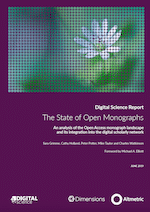Subscribe to our newsletter
Blog series on the State of Open Monographs 2020
About the authors: Cathy Holland, Director, Global Publisher Business Development at Digital Science, and Sara Grimme, Director of Strategic Accounts at Digital Science, have both been working in the scholarly publishing space for over 15 years.
Welcome to the first post of a specialized and dedicated book blog series supported by Digital Science. Like many colleagues working in scholarly publishing we have seen rapid changes in the industry over the last few years. Following a discussion on the future of the monograph with key leaders in the university press space at the 2018 ALPSP conference, we collaborated with thought leaders from the book space to produce a report on The State of Open Monographs. This report was well received by the community, so as a follow up we wanted to continue to explore this specialized, but very important, type of content.
With this blog series we aim to:
- Further the goals of the original report to bring a community together to discuss many topics important to books
- Educate, inform, and serve as a platform for sharing ideas that will be instructional for book publishers
- Work with a variety of people who care about book-specific topics and are experts in certain areas of book publishing
- Discuss ideas for overcoming certain challenges in the book space
We care about the book space – books are critical to the scholarly ecosystem
Through our exploration of the book space, we have come to understand that long-form research in the form of a monograph is a primary method of research communication in the social sciences and humanities. STEM fields, on the other hand, tell the world about their work in the form of journal articles. All segments of research contribute to society and the publishing community needs to be in a place to support all forms of output. The research ecosystem has come a long way from its early days when topics were siloed, research was printed, and various research communities did not talk to each other. Today research is continuing to be more and more interdisciplinary as topics in Social Science and Humanities cross over with STEM fields of study.
“Books, as the primary method of research communication in Social Science and Humanities fields, deserve to be treated as first-class research publications. It is time to weave them more strongly into the scholarly narrative and address challenges that stand in the way of doing just that.”
Monograph publishing has seen significant change in the last few years, particularly as a result of open access and funder mandates. However, it has also stayed frighteningly the same, with little changing in the metadata and publication space, leading to a continued state of disintermediation and fragmentation across publishers.
If we start with the state of funding, there has been significant confusion over the last 12-18 months regarding Plan S and open access mandates. Authors of monographs still find it extremely challenging to secure funding for their monograph (or even their book chapter!), and funders supporting journal publication feel very differently about the price of a £10-14,000 monograph – even in the face of an open access mission.
Disintermediation and fragmentation also remain an issue for monograph authors, whether publishing open access or not. A lack of consistency in metadata collection, paired with the fact that books tend to appear on multiple platforms, has led to issues around discoverability, access, and fragmentation of books.
In 2019 Digital Science worked with members of the scholarly community – in particular, Peter Potter and Charles Watkinson – to write a report on the current state of the open monograph. As Michael Elliot wrote in his introduction to the report:
“At a time when the research mission of higher education – particularly the research of the humanities and the social sciences – remains poorly understood beyond the academy, the mission of making our research widely and openly available could be more urgent than ever.”
The report exposed a number of issues in the open monograph ecosystem, or, as Michael put it, opportunities.
Key in the report was the fact that:
- The true value of monographs is obscured by a lack of metadata, identifiers, and a slow lag in the uptake of DOI’s
- Costs to transition monographs to a more open world are expensive, confusing, and lacking structure
- The publication of monographs tends to be driven by the needs of a print-based market, and as such, lag behind journals
We hope to explore each of these points in more detail over the course of this year. There are, in addition, many other themes that we see beyond those highlighted in the examples above.
Get involved and help share this blog series
We hope to expand on these issues with members of the community so that we are able to give you a space to share your thoughts, frustrations, and hopes for the future. Most importantly, we want to make this blog series of use! So if we can share best practices around metadata tagging, delve into providing real-time feedback to authors, or find new ways to communicate open funding mandates and sources with the community (both authors and publishers), then we will be fulfilling the purpose of this series.
In particular, we look forward to working closely with guest authors, each of whom will work on a theme close to their hearts, passions or frustrations! If you have an idea that you’d like to explore, or are keen to get involved, we’d love to hear from you. Please email publishing@digital-science.com if you’d like to hear more.
See the other posts in this series
DOI for this blog series: https://doi.org/10.6084/m9.figshare.12347939




